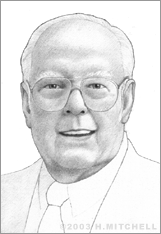James Hillier
James Hillier was born in Brantford, Ontario, Canada on August 22, 1915. He was interested in art as a youngster, and he first believed that he would pursue a career as an artist. But his natural talent for math and physics won him a scholarship to the University of Toronto, where he and fellow student Albert Prebus would later build the world's first practical electron microscope.
Hillier received his BA in Mathematics and Physics in 1937 and stayed on to pursue graduate studies at the University of Toronto. He and Prebus were students when, in 1937, they assembled a model of a microscope that could magnify up to 7,000 times the size of an object – much greater than the 2,000 times magnification produced by optical microscopes used at that time. This machine passed a beam of electrons, rather than a beam of light, through a specimen. The beam would then be focused on a photographic plate. A theory that was developed 15 years earlier by a German physicist had suggested that an electron microscope could have a resolving power much better than a light microscope, and Hillier and Prebus’ machine proved this to be true. Since electrons’ wavelength is smaller than the wavelength of light, greater magnification and depth of focus was indeed possible. The images created by this new type of microscope were as clear as an image on a modern television screen.
In 1938, Hillier received his MA from the University of Toronto, and in 1941, he completed his PhD. He was hired immediately by Radio Corporation of American (RCA) in Camden, New Jersey, where he worked with a group to build the company’s first commercial electron microscope. He worked on developing the microscope for more than a decade, expanding its application, improving its resolution, and helping to make the electron microscope standard equipment in labs, hospitals, and universities around the world. Eventually, magnification would improve to 10,000 times.
Hillier, who became a U.S. citizen in 1945, worked as a research engineer at RCA until 1953. He briefly joined Malpar, Inc., as the research director, then returned to RCA in 1954, where he became the general manager of RCA Laboratories in Princeton, New Jersey in 1957. He was eventually promoted to executive vice president and senior scientist of RCA Labs.
In addition to his work on the electron microscope, Hillier is also recognized for major developments related to the fields of medicine and biology, including his discovery of the principle of the stigmator for correcting astigmatism of electron microscope objective lenses and his invention of the electron microprobe microanalyser. He was also the first to picture tobacco mosaic viruses and an ultra-thin section of a single bacterium. He retired from RCA in 1977.
Over the course of his career, Hillier was awarded 40 patents and numerous accolades, including the American Public Health Association's Albert Lasker Award in Medical Research in 1960, the IEEE David Sarnoff Award in 1967, the Industrial Research Institute Medal in 1975, induction into the U.S. National Inventors Hall of Fame in 1980, and the IEEE Founders Medal in 1980.
Hillier, who passed away in January 2007, was a Fellow of the American Physical Society, the American Association for the Advancement of Science, and the Institute of Electrical and Electronics Engineers. He was also a member of Sigma Xi and the National Academy of Engineering. In addition, he established the James Hillier Foundation, which awards scholarships to promising science students from his hometown of Brantford.


